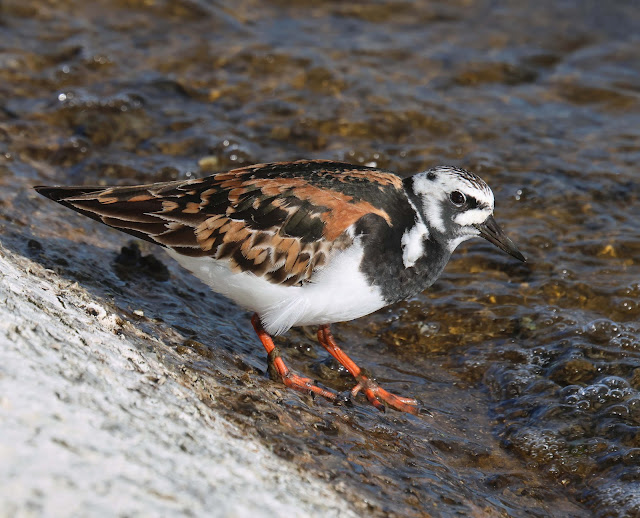Having recently returned from The Isle of Arran in Scotland Turnstones were very much in my mind as I saw them every day there, either feeding in the seaweed or resting on the rocky shores of Arran before continuing their journey north to breed.
Back now in Oxfordshire I was wandering along the reservoir causeway at Farmoor on a late afternoon when what did I come across but two familiar stocky waders silhouetted in the bright sunshine. Walking nearer my suspicions were confirmed.They were Turnstones in summer plumage, feeding contentedly by the water's edge.
Turnstones do not breed in Britain but are a familiar wader that spends the winter in Britain along rocky seashores and often become quite tame where they come into contact with humanity, such as in coastal towns and villages.They have an almost worldwide wintering distribution that consists of five populations but only three of these occur in Britain.
Turnstones are an occasional visitor to the reservoir on both their northward and return migration, stopping over for a day or so to feed and rest.
For the most part they are relatively confiding and untroubled by the increasing number of passers by (post covid) on the causeway and are generally ignored by all but us birders who enjoy seeing them here, however briefly, transformed from drab winter browns into their splendid tortoiseshell breeding plumage which makes them one of the most colourful of the four small wader species that visit the reservoir on migration. Occasionally a close pass by a yachting dinghy or windsurfer upsets their equanimity and they fly but usually will choose to settle further along the causeway rather than depart the reservoir altogether.
For me, as I look at them and take far too many photographs, the wonder of what they are instinctively undertaking is never far from my mind and it cannot fail but catch at my emotions. For another year, on this pleasant afternoon the wonderful act of migration is personified by their presence.
The same questions arise every time I find myself in this situation. Where for instance have they come from? Probably they spent the winter on British shores or possibly they have come from further afield such as Southern Europe or even West Africa.
Where are they going? By crossing middle England, such as these two at Farmoor today, are they taking a short cut as they head northwest to somewhere I can only imagine in the far distant Arctic. Do some reach their destination in one flight while others stop off on the way, such as at Farmoor, before undertaking the next stage of their barely credible journey.
Visible migration is always inspiring, even moving, bringing a sense of the wider world to otherwise unexceptional locations such as a prosaic inland reservoir in Oxfordshire, and instills within me an unexplained sense of urgency and excitement that has no relation to my personal circumstances. It is a heady feeling.
I found some of the answers to my questions about the Turnstone's migration in The Migration Atlas published by The British Trust for Ornithology.
The Turnstones that briefly stop at Farmoor have a formidable distance to go to get to their breeding grounds. The vast majority of Turnstones found passing through Britain are bound for the northeast Canadian Axel Heiberg and Ellesmere Islands or northern Greenland. Around half will make a stopover in Iceland.
The main exodus from Britain is in April and May and depending on their fat reserves laid down to power their flight, some will fly to Canada and Greenland directly, others will make it as far as Iceland where they will stop to feed and build up their fat reserves once more before flying on over the Greenland icecap to reach northwest Greenland and northeast Canada.Yet others will make several stops in Britain, moving progressively northwestwards before heading out over the North Atlantic
It is a true wonder of the natural world.
So next time you see a migrating Turnstone, stop to consider the journey they will make twice a year, flying an incredible distance to breed and raise the next generation of Turnstones in a short window of six to seven-weeks in the Arctic. As you look at a Turnstone, maybe wandering along the mundane concrete shore of Farmoor in either spring or autumn, marvel at this small bird and its accomplishments.
Before our eyes is something that should cause us all to stop and ponder on this still wonderful world and the creatures that inhabit it, such as the familiar Turnstone whose existence in its natural course encompasses travels at which we can only marvel.
This week is Mental Health Awareness Week and the concept of mindfulness is much bandied about these days, especially as a result of burgeoning mental health problems exacerbated by the recent pandemic.This blogpost is probably reaching those of us who are well aware of the healing qualities of the natural world and birds in particular. Birds are all around us, although in alarmingly reduced numbers and their obvious presence apparently catches the general public's imagination.These triumphs of nature, such as the Turnstone's incredible life story, can and will cause others to see that nature is of huge worth and we should not ignore or take it for granted but rather reflect on its marvels as well as its benefits to our mental well being and lives in general.
A general acceptance of this fact will, in my opinion, make this world a happier place to inhabit..











No comments:
Post a Comment